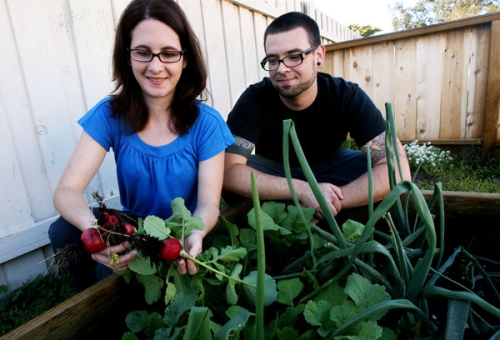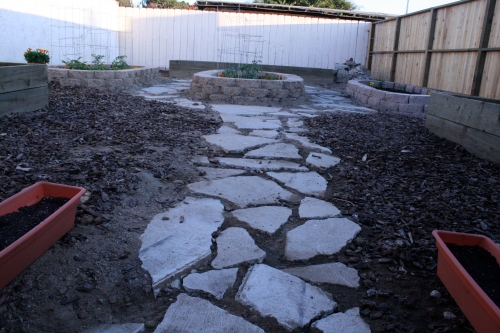
Jules Dervaes seeks his kid's input before answering a question from the audience after the film screening of "Homegrown Revolution", a short documentary of their urban homestead in Pasadena where they grow 6,000 pounds of produce on one tenth of an acre each year. Photo by Christopher.
Watching Kerri gently raise her garden over the last few weeks has been quite a treat. The look she gets when something new has sprouted, and the sheer excitement that radiates from her as she checks in on the food landscape that is taking over our patio is inspiring. While I have borne witness to several new crops grown from seeds recently, what we saw today takes urban gardening to a whole new level.
Jules Dervaes and his three adult children have been growing their own food, and working to live off the grid for nearly a decade. Their urban homestead located in Pasadena is both a revolution in living and a model for self-sufficency. Their short film “Homegrown Revolution” was shown today as part of the Cottonwood Environmental Film Festival here in Encinitas, and the Dervaes family was present to answer questions and distribute information from a booth in the back of the room.
The short film documents how the Dervaes have transformed 1/10 of an acre, which used to include a driveway, into a 6,000 pound urban garden that offers up 350 types of useful and edible plants each year. They use every inch of space, which includes vertical gardening, and during the summer are able to provide up to 80 percent of their food needs. During the winter it’s about 50 percent. In contrast, their lawn growing neighbors have little to show for their own patches of earth just 130 feet from the freeway.
Overall, the Dervaes eat about 60 percent of what they grow, sell 30 percent to local chefs, and use the remaining 10 percent to feed to the small number of chickens, ducks and goats that help produce compost.
“The animals help complete the cycle,” Dervaes said as he answered a question from an audience member after the screening.
The few animals they have aren’t for eating, as the family maintains a near-vegetarian diet, but they do eat some of the eggs and milk produced by their furry and feathered friends. The youngest daughter, Jordanne, says they’re more like pets really and that each one has a name. She even takes the goats hiking.
Beyond the growing of food, the family also uses solar energy, human powered appliances (including a bike blender), a graywater system (including an outdoor shower) and would not dare using chemicals to keep away pests. Their nine different compost systems have put their land 18 inches above the plot next door.
This short film however was only a prologue to the feature length film “Fresh” that screened directly afterward.
For those of you who have read Michael Pollan’s “Omnivore’s Dilemma”, this film could have very well been a companion to the section where Pollan is on the Salatin farm. While Pollan himself is interveiwed throughout, seeing Joel Salatin and the farm that Pollan works hard to describe in his book, is the best part of this film.
Filmmaker Ana Sofia Joanes has done a good job of weaving together a few different stories of where our food comes from, and in doing so allows viewers to see that another type of food system is possible, if we’re willing to get our hands dirty, or commit to supporting closed cycle farms that are looking to feed people instead of mono cropping corn and soy to process into other products.
Both films were inspiring, but I’m not convinced that the solutions proposed by either film are going to gain much traction with the majority of Americans who prize convenience above all else. My dad is not going to start a garden, and I’m pretty sure he’s not alone. However, a move in this direction is absolutely essential if we are going to survive as a species.
Unfortunately the one in nine Americans now receiving food stamps is less equipped to make such a radical transition, as many people are just trying to make it to the next paycheck (if they’re lucky enough to have a job – unemployment is now 9.4 percent). If you are paying attention, you know that the United States has reached a record level of federal assistance this week. More Americans than ever before are struggling to feed their families.
Over the last few days there were also several thought-provoking food tidbits to consider. Author Tom Standage was interviewed on National Public Radio about his book “An Edible History of Humanity”, and Jim Motavalli wrote a well reasoned opinion piece in Foreign Policy magazine predicting the oncoming vegetarian revolution; he writes that it will come by force rather than choice, and the comments are also worth sifting through.
Until next week,
Christopher





